Rotational Stiffness and Carrying Capacity of Timber Frame Corners with Dowel Type Connections
Abstract
:1. Introduction
2. Materials and Methods
2.1. Description of Construction and Geometry
2.2. Experiment Setup No. 1—Joint Created from a Combination of Bolts and Pins
2.3. Experiment Setup No. 2—Joint Created from Full Threaded Screws
2.4. Description of Sensor Location
2.5. Description of Test Equipment
2.6. Description of the Loading Process
2.7. Calculation of the Load-Bearing Capacity of the Frame Connection
- Fv,Rk is the characteristic load-bearing capacity of one cut of one fastener;
- ti is the wood thickness 1 or 2;
- d is the diameter of the fasteners;
- My,Rk is the characteristic plastic moment of bearing capacity of the fastener;
- β is the ratio between the compressive strengths of the elements; and
- Fax,Rk is the characteristic axial load capacity for pulling out the fasteners.
2.8. Calculation of Translational and Rotational Stiffness of a Frame Connection
2.9. Calculation of Translational Stiffness
- ρm is the average density of the connected wooden element; and
- d is the diameter of the fastener.
- lef is the effective length of screw penetration; and
- d is the screw diameter.
- n is number of fasteners; and
- Ku is translational stiffness of the fasteners in Relation (5).
2.10. Calculation of Rotational Stiffness
- Ku and Kser are the slip module in ULS and SLS, respectively in Relations (4) and (5).
2.11. Numerical Model
2.12. Experimental Testing
3. Results
3.1. Determination of Bearing Capacity and Rotational Stiffness of Joints for Test Sample No. 1 and No. 3, Full Threaded Screws, on the Basis of Standard and the Literature
3.2. Determination of Bearing Capacity and Rotational Stiffness of Joints for Test Sample No. 2 and No. 4, Bolts and Pins, on the Basis of Standard and Literature
3.3. Comparison of Numerical Model and Experimental Testing
3.4. Determination of Bearing Capacity Based on Experimental Testing
3.5. Determination of Rotational Stiffness Based on Experimental Testing
3.6. Measured Rotational Stiffness from Experimental Testing
3.7. Graphical Comparison of the Results of Numerical Modeling and Experimental Testing
4. Discussion
5. Conclusions
Author Contributions
Funding
Institutional Review Board Statement
Informed Consent Statement
Data Availability Statement
Acknowledgments
Conflicts of Interest
References
- Mirski, R.; Dziurka, D.; Chuda-Kowalska, M.; Kawalerczyk, J.; Kuliński, M.; Łabęda, K. The Usefulness of Pine Timber (Pinus sylvestris L.) for the Production of Structural Elements. Part II: Strength Properties of Glued Laminated Timber. Materials 2020, 13, 4029. [Google Scholar] [CrossRef]
- Mirski, R.; Dziurka, D.; Chuda-Kowalska, M.; Wieruszewski, M.; Kawalerczyk, J.; Trociński, A. The Usefulness of Pine Timber (Pinus sylvestris L.) for the Production of Structural Elements. Part I: Evaluation of the Quality of the Pine Timber in the Bending Test. Materials 2020, 13, 3957. [Google Scholar] [CrossRef]
- Bragov, A.; Igumnov, L.; dell’Isola, F.; Konstantinov, A.; Lomunov, A.; Iuzhina, T. Dynamic Testing of Lime-Tree (Tilia Europoea) and Pine (Pinaceae) for Wood Model Identification. Materials 2020, 13, 5261. [Google Scholar] [CrossRef]
- Olaoye, K.; Aguda, L.; Ogunleye, B. Prediction of Mechanical Properties of Hardwood Species Using the Longitudinal Vibration Acoustic Method. For. Prod. J. 2021, 71, 391. [Google Scholar] [CrossRef]
- Nowak, T.; Patalas, F.; Karolak, A. Estimating Mechanical Properties of Wood in Existing Structures—Selected Aspects. Materials 2021, 14, 1941. [Google Scholar] [CrossRef]
- Malo, K.A.; Abrahamsen, R.B.; Bjertnæs, M.A. Some structural design issues of the 14-storey timber framed building “Treet” in Norway. Eur. J. Wood Prod. 2016, 74, 407–424. [Google Scholar] [CrossRef] [Green Version]
- Crocetti, R. Large-span timber structures. In Proceedings of the World Congress on Civil, Structural and Environmental Engineering (CSEE′16), Prague, Czech Republic, 30–31 March 2016; pp. 1–23. [Google Scholar] [CrossRef]
- Frühwald, E. Analysis of structural failures in timber structures: Typical causes for failure and failure modes. Eng. Struct. 2011, 33, 2978–2982. [Google Scholar] [CrossRef]
- Steiger, R.; Serrano, E.; Stepinac, M.; Rajčić, V.; O’Neill, C.; McPolin, D.; Widmann, R. Strengthening of timber structures with glued-in rods. Constr. Build. Mater. 2015, 97, 90–105. [Google Scholar] [CrossRef] [Green Version]
- Vavrusova, K.; Mikolasek, D.; Lokaj, A.; Klajmonova, K.; Sucharda, O. Determination of carrying capacity of steel-timber joints with steel rods glued-in parallel to grain. Wood Res. 2016, 61, 733–740. [Google Scholar]
- Solarino, F.; Giresini, L.; Chang, W.-S.; Huang, H. Experimental Tests on a Dowel-Type Timber Connection and Validation of Numerical Models. Buildings 2017, 7, 116. [Google Scholar] [CrossRef] [Green Version]
- Zhou, S.R.; Li, Z.Y.; Feng, S.Y.; Zhu, H.; Kang, S.B. Effects of bolted connections on behaviour of timber frames under combined vertical and lateral loads. Constr. Build. Mater. 2021, 293, 123542. [Google Scholar] [CrossRef]
- Bouchaïr, A.; Racher, P.; Bocquet, J.F. Analysis of dowelled timber to timber moment-resisting joints. Mater. Struct. 2007, 40, 1127–1141. [Google Scholar] [CrossRef]
- Wang, M.; Song, X.; Gu, X.; Tang, J. Bolted glulam beam-column connections under different combinations of shear and bending. Eng. Struct. 2019, 181, 281–292. [Google Scholar] [CrossRef]
- Johanides, M.; Kubincova, L.; Mikolasek, D.; Lokaj, A.; Sucharda, O.; Mynarcik, P. Analysis of Rotational Stiffness of the Timber Frame Connection. Sustainability 2021, 13, 156. [Google Scholar] [CrossRef]
- Wang, X.T.; Zhu, E.C.; Niu, S.; Wang, H.J. Analysis and test of stiffness of bolted connections in timber structures. Constr. Build. Mater. 2021, 303, 124495. [Google Scholar] [CrossRef]
- Noguchi, M.; Komatsu, K. A new method for estimating stiffness and strength in bolted timber-to-timber joints and its verification by experiments (II): Bolted cross-lapped beam to column joints. J. Wood Sci. 2004, 50, 391–399. [Google Scholar] [CrossRef]
- Glišovíc, I.; Stevanovíc, B.; Kočetov-Mišulić, T. Embedment test of wood for dowel-type fasteners. Wood Res. 2012, 57, 639–650. [Google Scholar]
- Karagiannis, V.; Málaga-Chuquitaype, C.; Elghazouli, A.Y. Modified foundation modelling of dowel embedment in glulam connections. Constr. Build. Mater. 2016, 102, 1168–1179. [Google Scholar] [CrossRef] [Green Version]
- Blass, H.J.; Sandhaas, C. Timber Engineering—Principles for Design; Karlsruher Institut für Technologie: Karlsruhe, Germany, 2017; ISBN 978-3-7315-0673-7. [Google Scholar]
- Požgaj, A.; Kürjatko, S. Wood properties of spruce from forests affected by pollution in Czechoslovakia. IAWA J. 1986, 7, 405–410. [Google Scholar] [CrossRef]
- Widmann, R.; Fernandez-Cabo, J.L.; Steiger, R. Mechanical properties of thermally modified beech timber for structural purposes. Eur. J. Wood Wood Prod. 2012, 70, 775–784. [Google Scholar] [CrossRef] [Green Version]
- Gao, S.; Xu, M.; Guo, N.; Zhang, Y. Mechanical properties of glued-laminated timber with different assembly patterns. Adv. Civ. Eng. 2019, 2019, 9495705. [Google Scholar] [CrossRef] [Green Version]
- Smiroldo, F.; Giongo, I.; Piazza, M. Use of timber panels to reduce the seismic vulnerability of concrete frame structures. Eng. Struct. 2021, 244, 112797. [Google Scholar] [CrossRef]
- Yaremchuk, L.; Olyanyshen, T.; Hogaboam, L. Selection of coating materials for wood finishing based on a hierarchical analysis method of their technological, economic and ecological criteria. Int. J. Energy Technol. Policy 2016, 12, 295–311. [Google Scholar] [CrossRef]
- Lindfors, N.C.; Salo, J. New ecological wood–plastic composite materials for scaphoid-type casting: Material properties and clinical evaluation. Hand Ther. 2014, 19, 67–72. [Google Scholar] [CrossRef]
- Jorissen, A.J.M.; Leijten, A.J.M. Tall timber buildings in the netherlands. Struct. Eng. Int. J. Int. Assoc. Bridge Struct. Eng. 2008, 18, 133–136. [Google Scholar] [CrossRef]
- Leijten, A.J.M.; Brandon, D. Advances in moment transfering dvw reinforced timber connections—Analysis and experimental verification, part 1. Constr. Build. Mater. 2013, 43, 614–622. [Google Scholar] [CrossRef] [Green Version]
- Kasal, B.; Pospisil, S.; Jirovsky, I.; Heiduschke, A.; Drdacky, M.; Haller, P. Seismic performance of laminated timber frames with fiber-reinforced joints. Earthq. Eng. Struct. Dyn. 2004, 33, 633–646. [Google Scholar] [CrossRef]
- Aruova, L.B.; Ospanova, Z.N.; Aruov, B.B.; Alibekova, N.T.; Shashpan, Z.A.; Kyrgizbaev, A.T. Cyclic tests of joints of glued wooden structures. IOP Conf. Ser. Mater. Sci. Eng. 2020, 829, 012017. [Google Scholar] [CrossRef]
- Bachtiar, E.V.; Clerc, G.; Brunner, A.J.; Kaliske, M.; Niemz, P. Static and dynamic tensile shear test of glued lap wooden joint with four different types of adhesives. Holzforschung 2017, 71, 391–396. [Google Scholar] [CrossRef] [Green Version]
- Jung, K.; Murakami, S.; Kitamori, A.; Chang, W.; Komatsu, K. Improvement of glued-in-rod joint system using compressed wooden dowel. Holzforschung 2010, 64, 799–804. [Google Scholar] [CrossRef]
- Candelas-Gutierrez, A. The power of geometric relationships in mudéjar timber roof frames. Nexus Netw. J. 2017, 19, 521–545. [Google Scholar] [CrossRef]
- Blaß, H.J.; Schädle, P. Ductility aspects of reinforced and non-reinforced timber joints. Eng. Struct. 2011, 33, 3018–3026. [Google Scholar] [CrossRef]
- Cajka, R.; Burkovic, K. Coupled timber-concrete ceiling using bonded shear connectors. Adv. Mater. Res. 2013, 772, 130–135. [Google Scholar] [CrossRef]
- Lokaj, A.; Dobes, P.; Sucharda, O. Effects of Loaded End Distance and Moisture Content on the Behavior of Bolted Connections in Squared and Round Timber Subjected to Tension Parallel to the Grain. Materials 2020, 13, 5525. [Google Scholar] [CrossRef] [PubMed]
- Winter, S.; Dietsch, P. Eurocode 5—Design of timber structures. [Eurocode 5—Bemessung und konstruktion von holzbauwerken]. Bauingenieur 2011, 86, 348–355. [Google Scholar]
- Kleinhenz, M.; Winter, S.; Dietsch, P. Eurocode 5—A halftime summary of the revision process. In Proceedings of the WCTE 2016—World Conference on Timber Engineering, Vienna, Austria, 22–25 August 2016. [Google Scholar]
- Bemessung Nach Eurocode 5. Holz Kurier 2001, 56, 15.
- ČSN EN 1995-1-1. Eurocode 5: Design of Timber Structures—Part 1-1: General—Common Rules and Rules for Buildings; Czech Standards Institute: Praha, Czech Republic, 2006.
- Wooden Structures According to Eurocode 5. STEP 1: Design and Construction Materials; Bohumil, K., Translator; KODR: Zlin, Czech Republic, 1998; ISBN 80-238-2620-4. (In Czech)
- Ahlborn. Available online: https://www.ahlborn.com/ (accessed on 25 November 2021).
- EN 26891:1991. Timber Structures—Joints Made with Mechanical Fasteners—General Principles for the Determination of Strength and Deformation Characteristics (ISO 6891-1983); ISO: Geneva, Switzerland, 1999.
- Wooden Structures According to Eurocode 5; STEP 2: Design of Details and Load-Bearing Systems; Koželouh, B., Translator; ČKAIT Information Center: Prague, Czech Republic, 2004; ISBN 80-86769-13-5. (In Czech)
- SCIA Engineer Software. Available online: https://www.scia.net/en/software/scia-engineer (accessed on 26 March 2021).
- ANSYSTM Software. Available online: https://www.ansys.com (accessed on 26 March 2021).
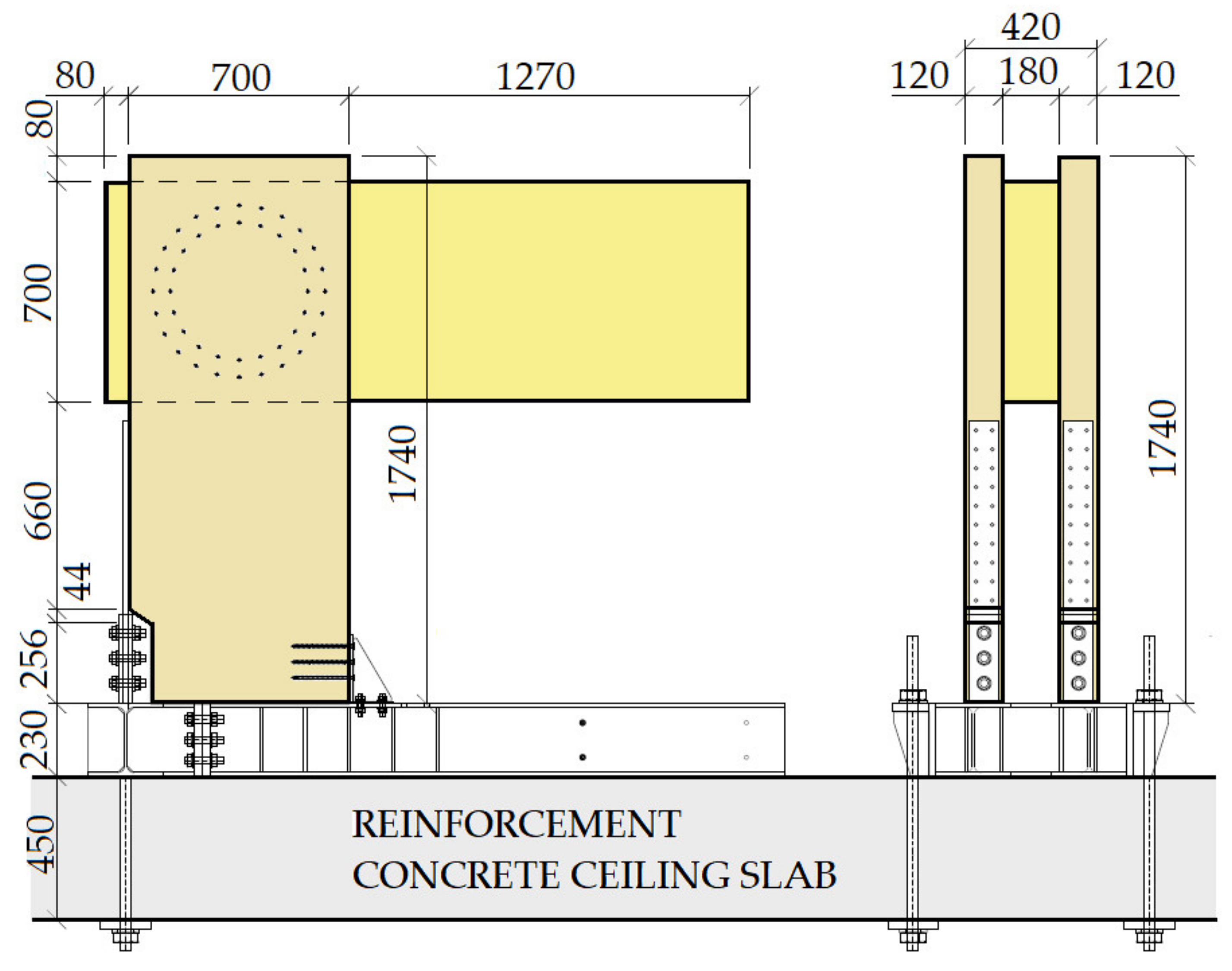


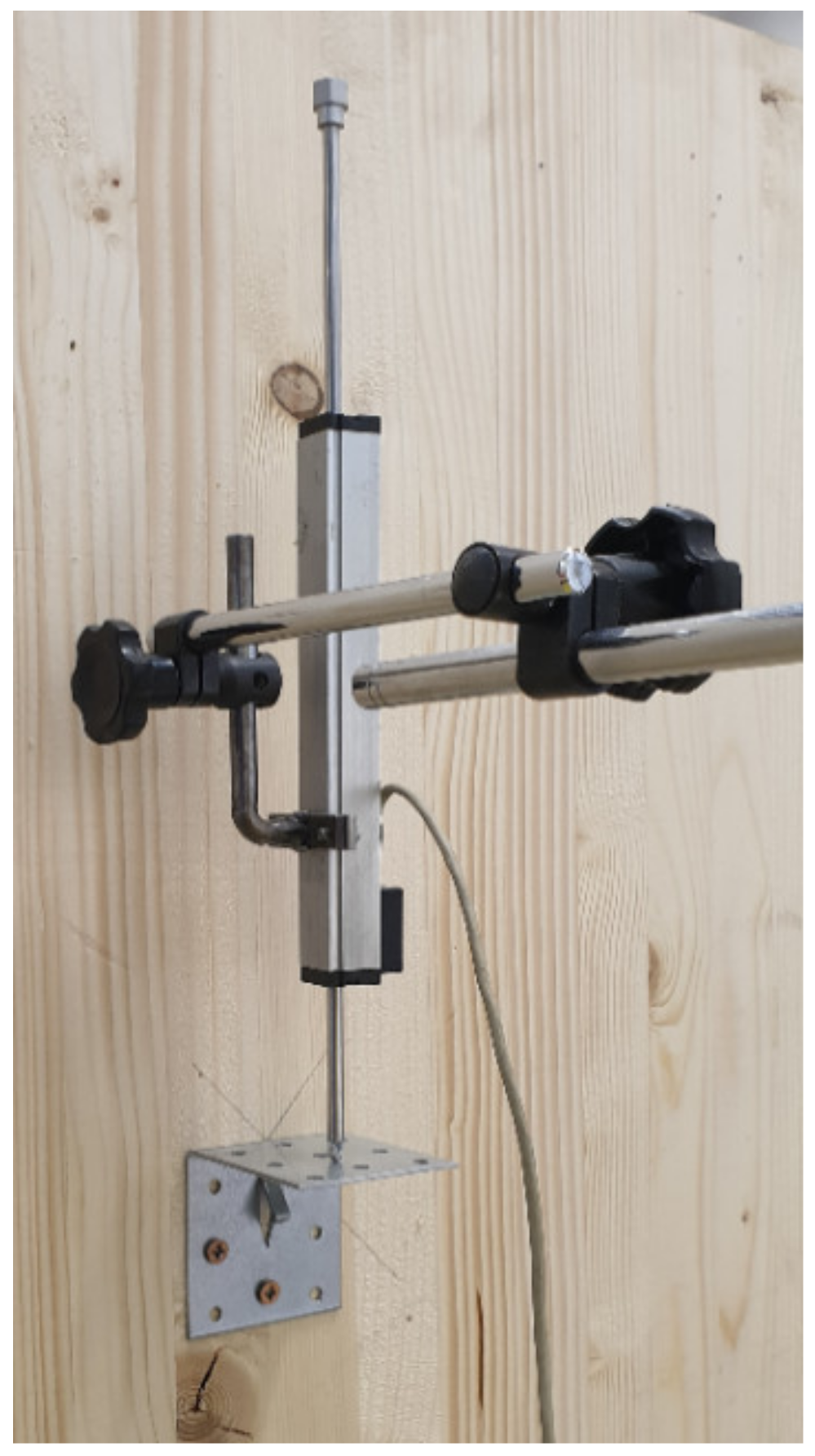
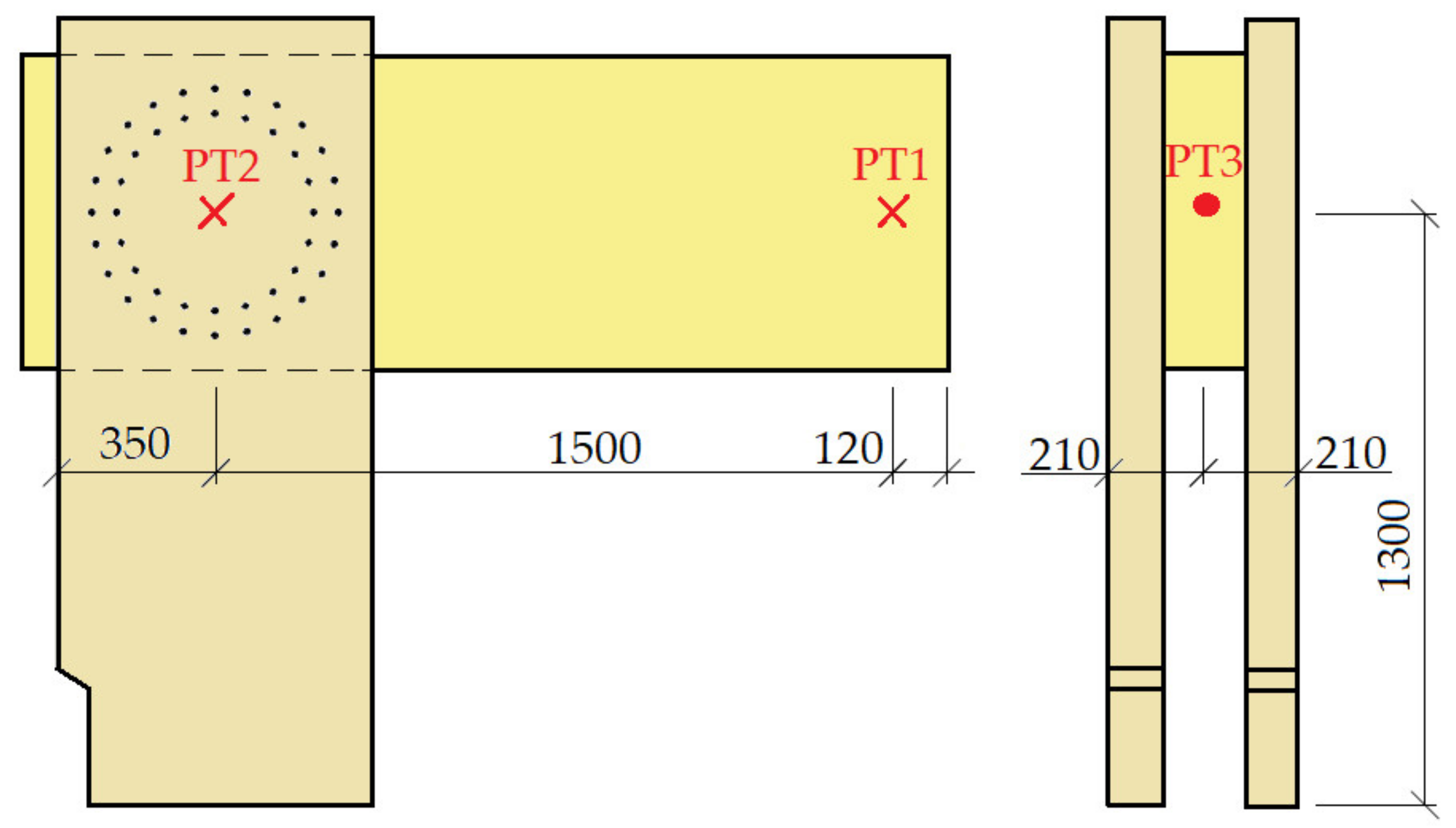
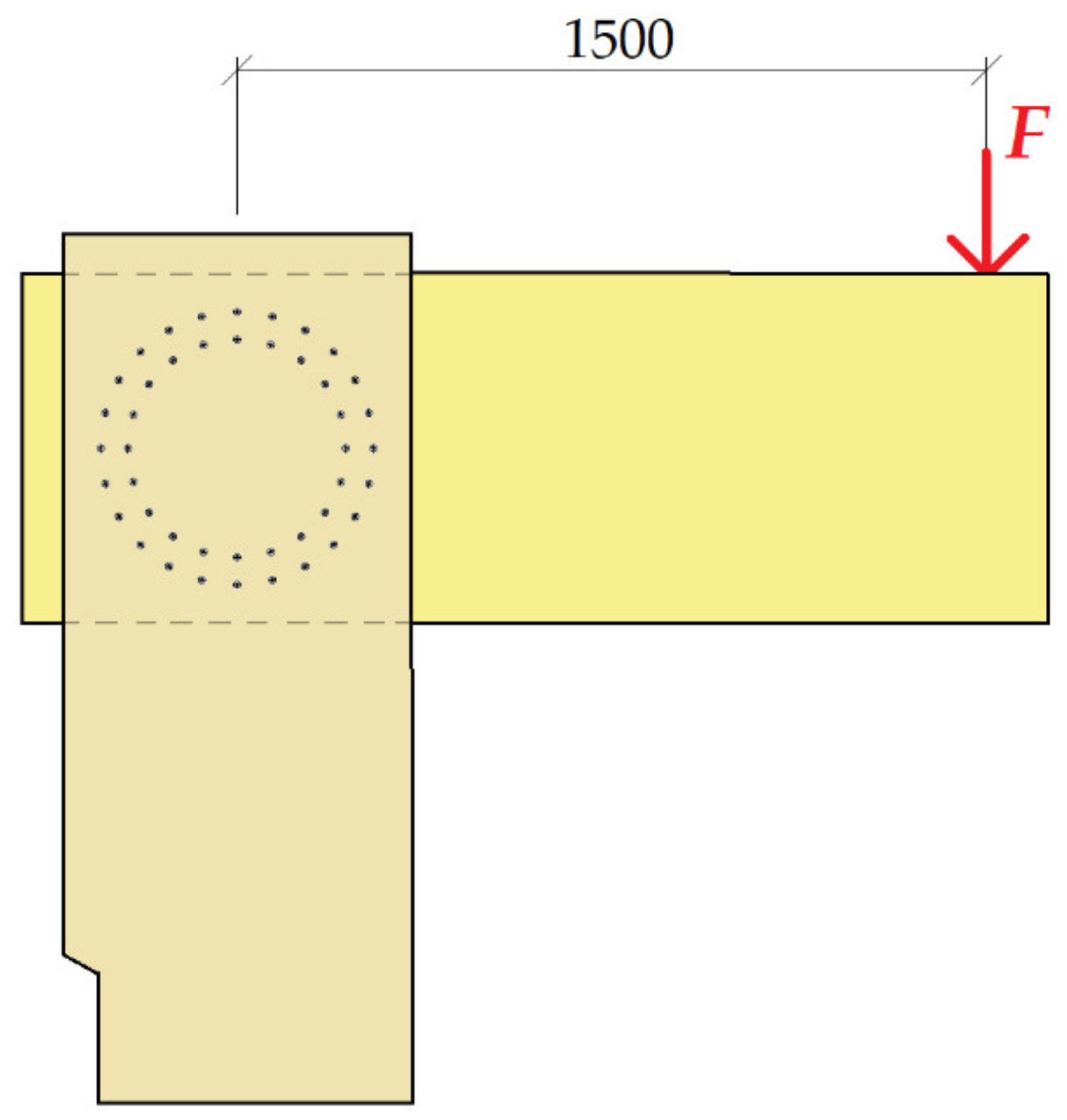
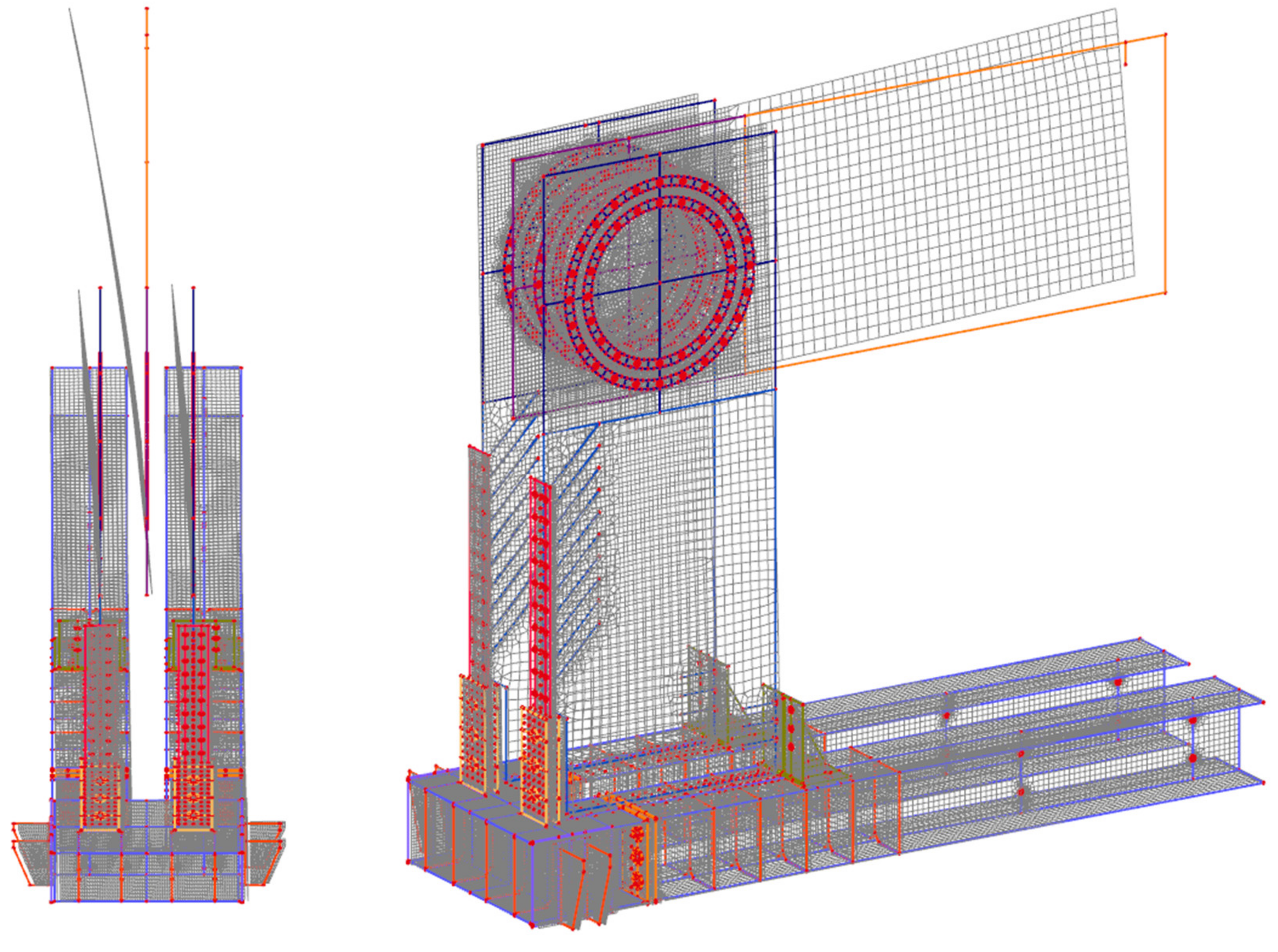

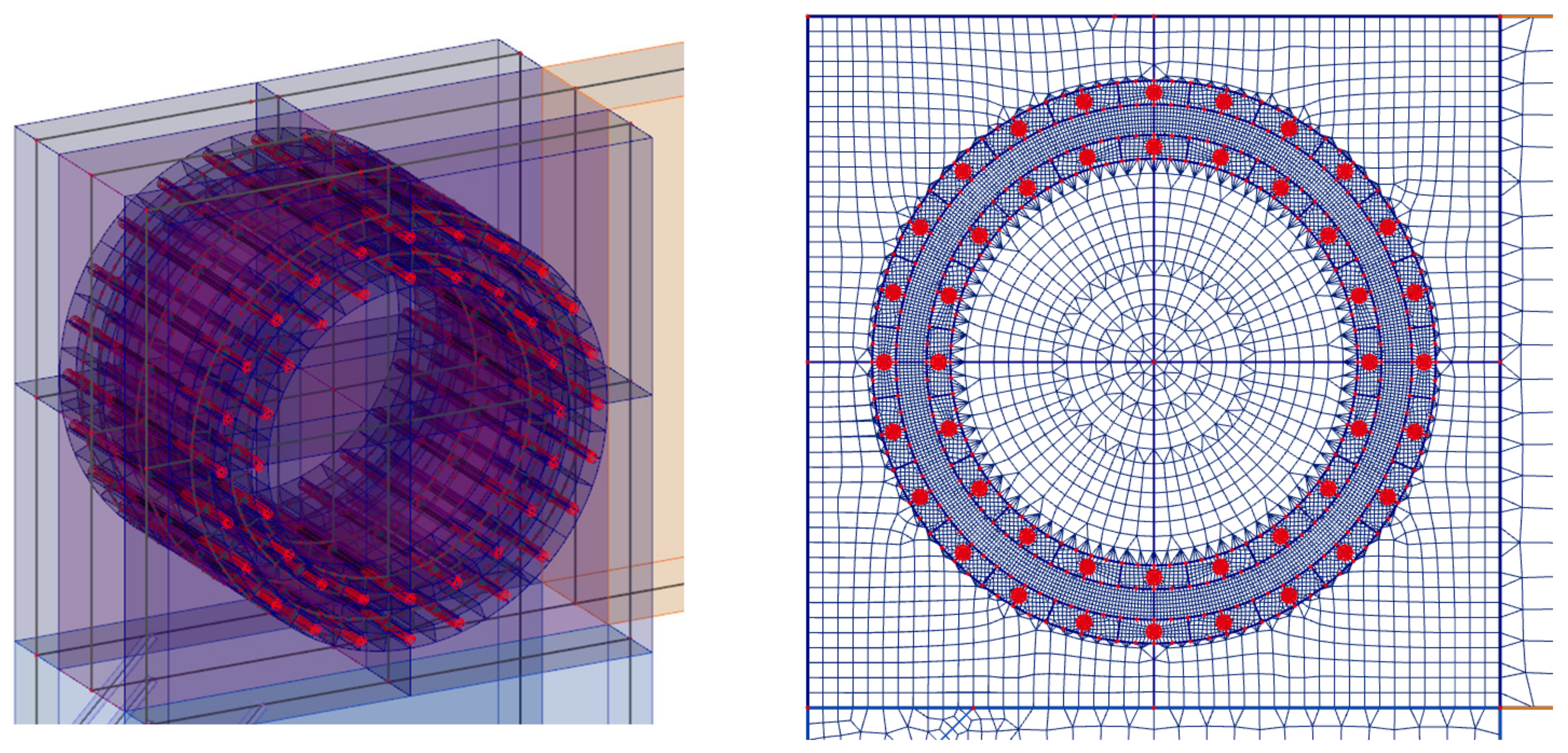
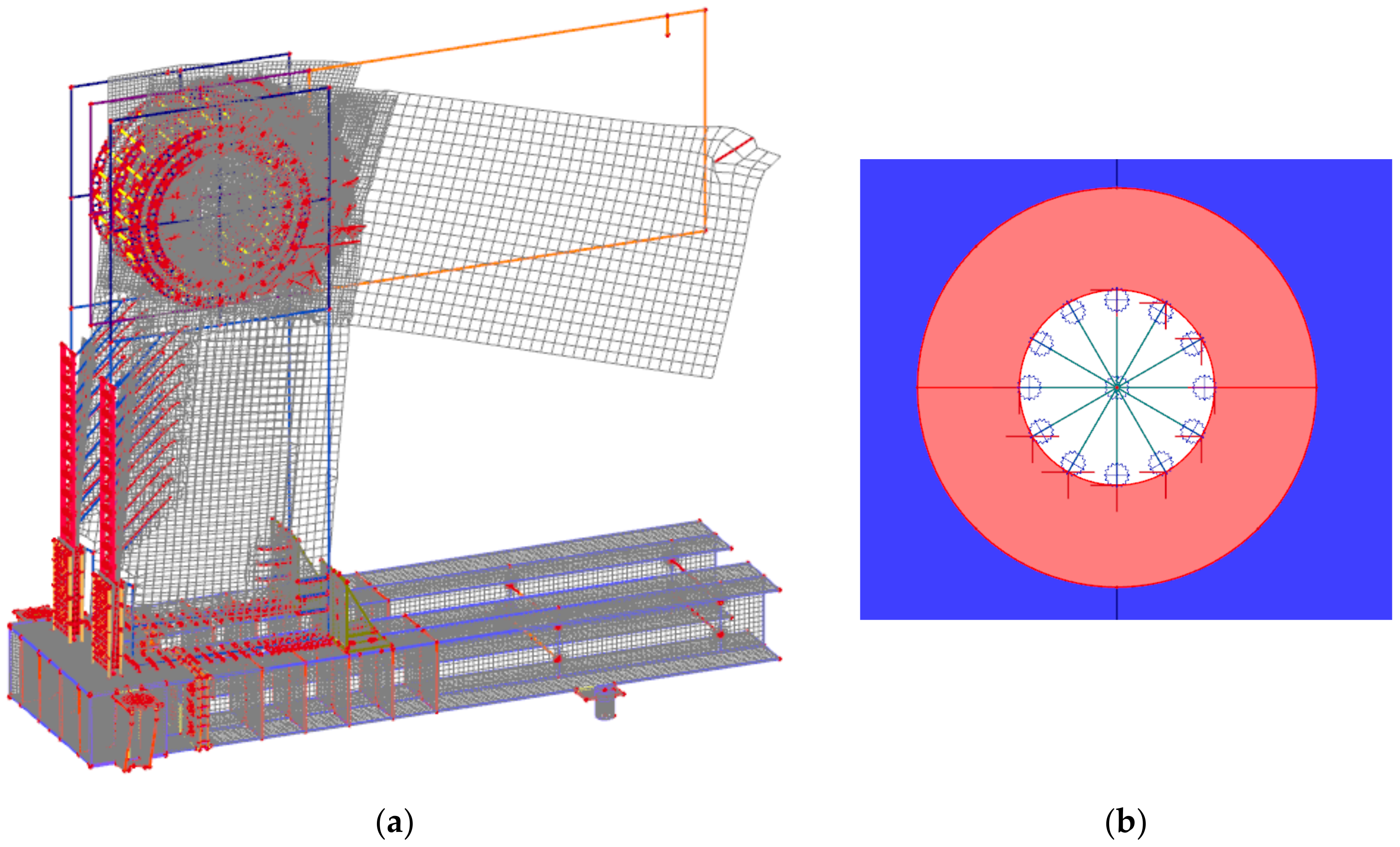
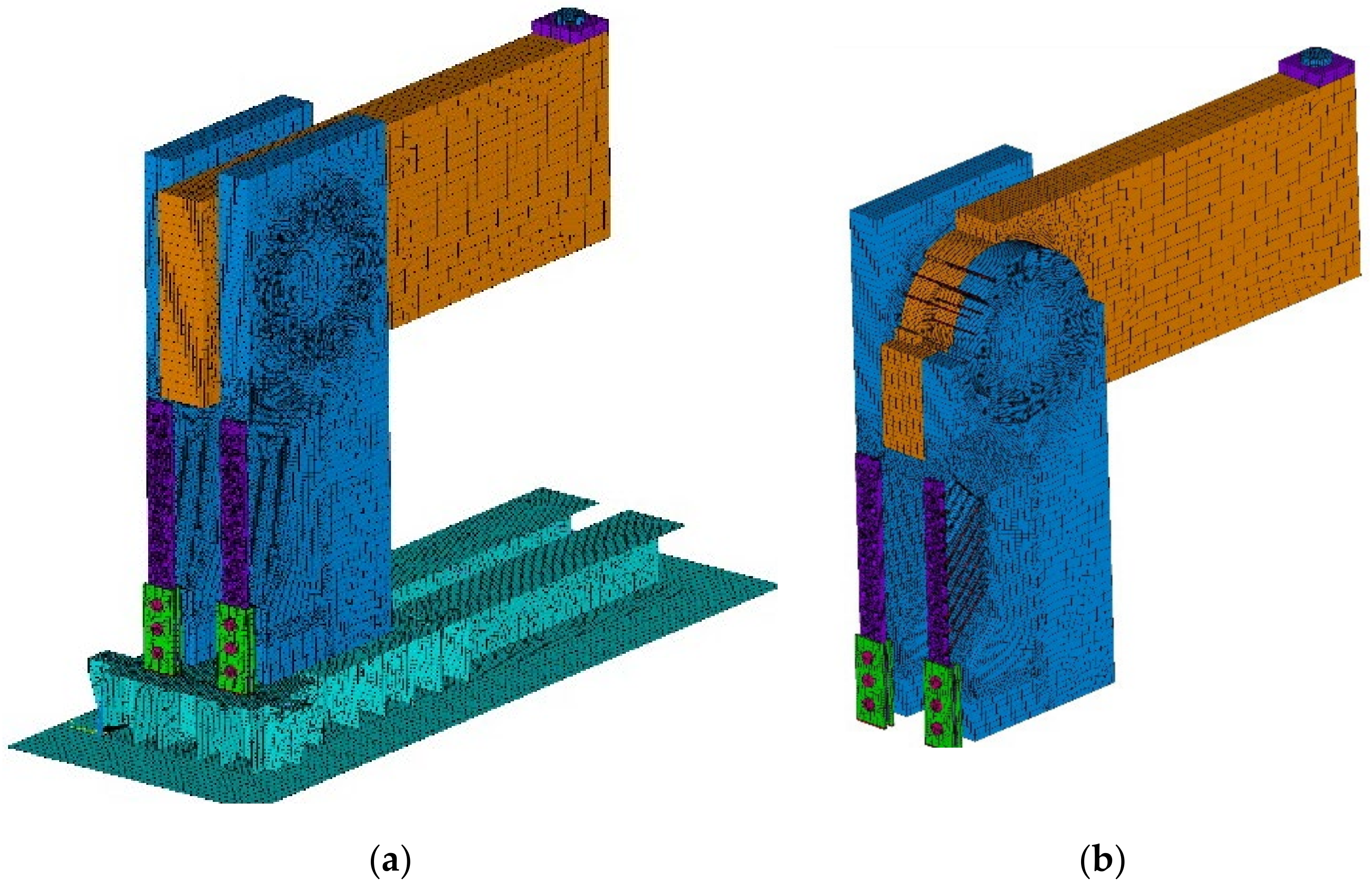
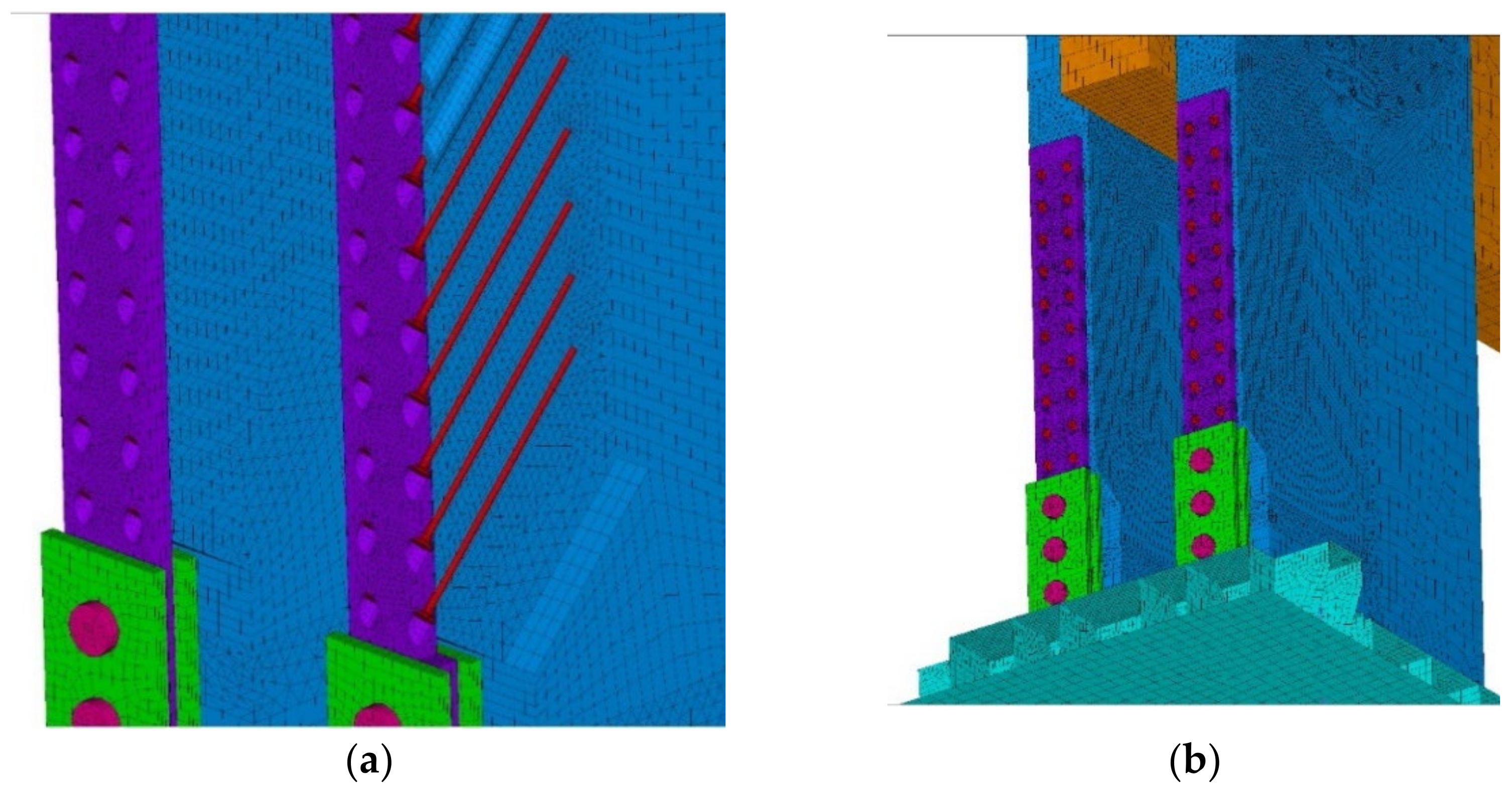
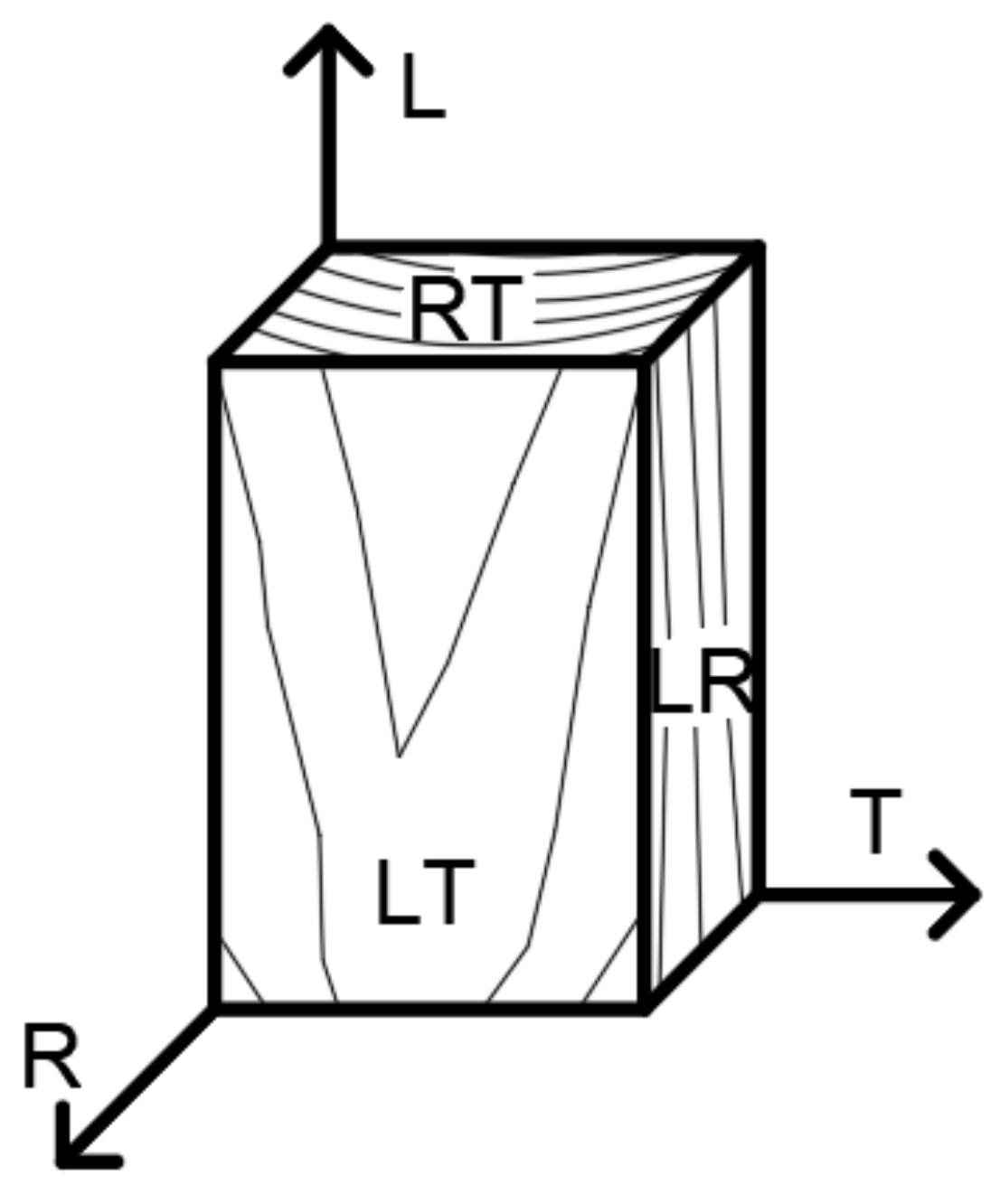
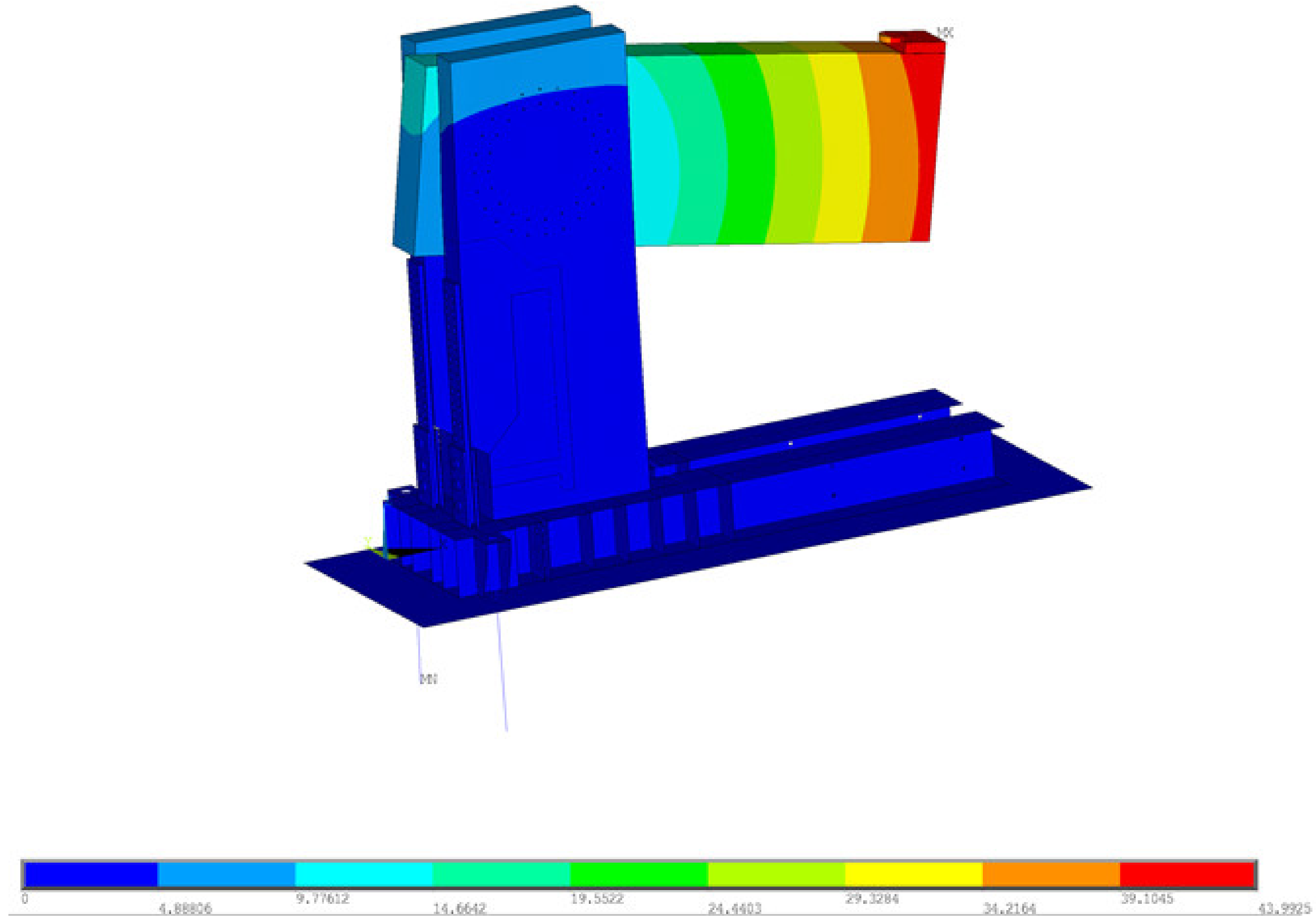

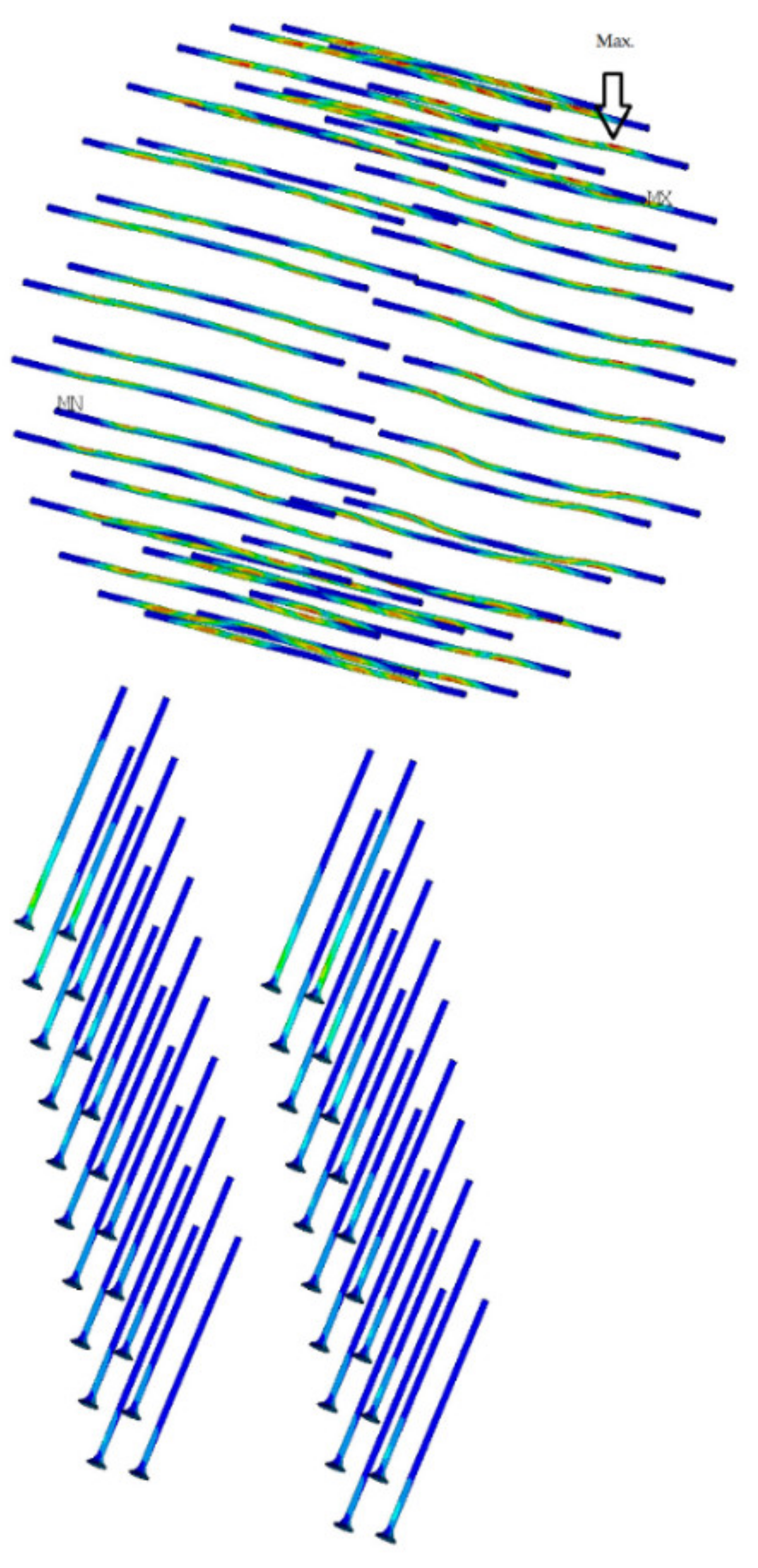
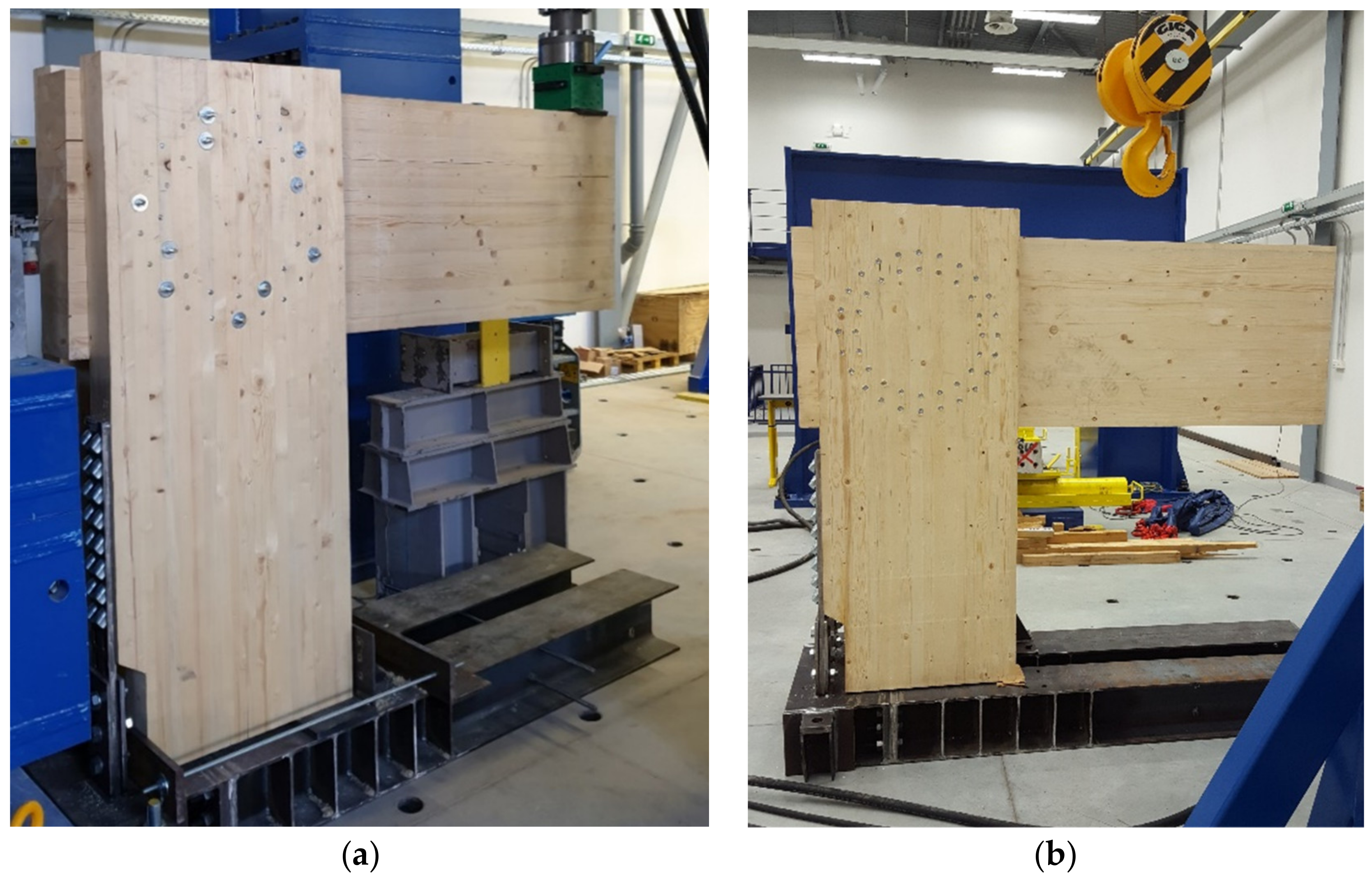

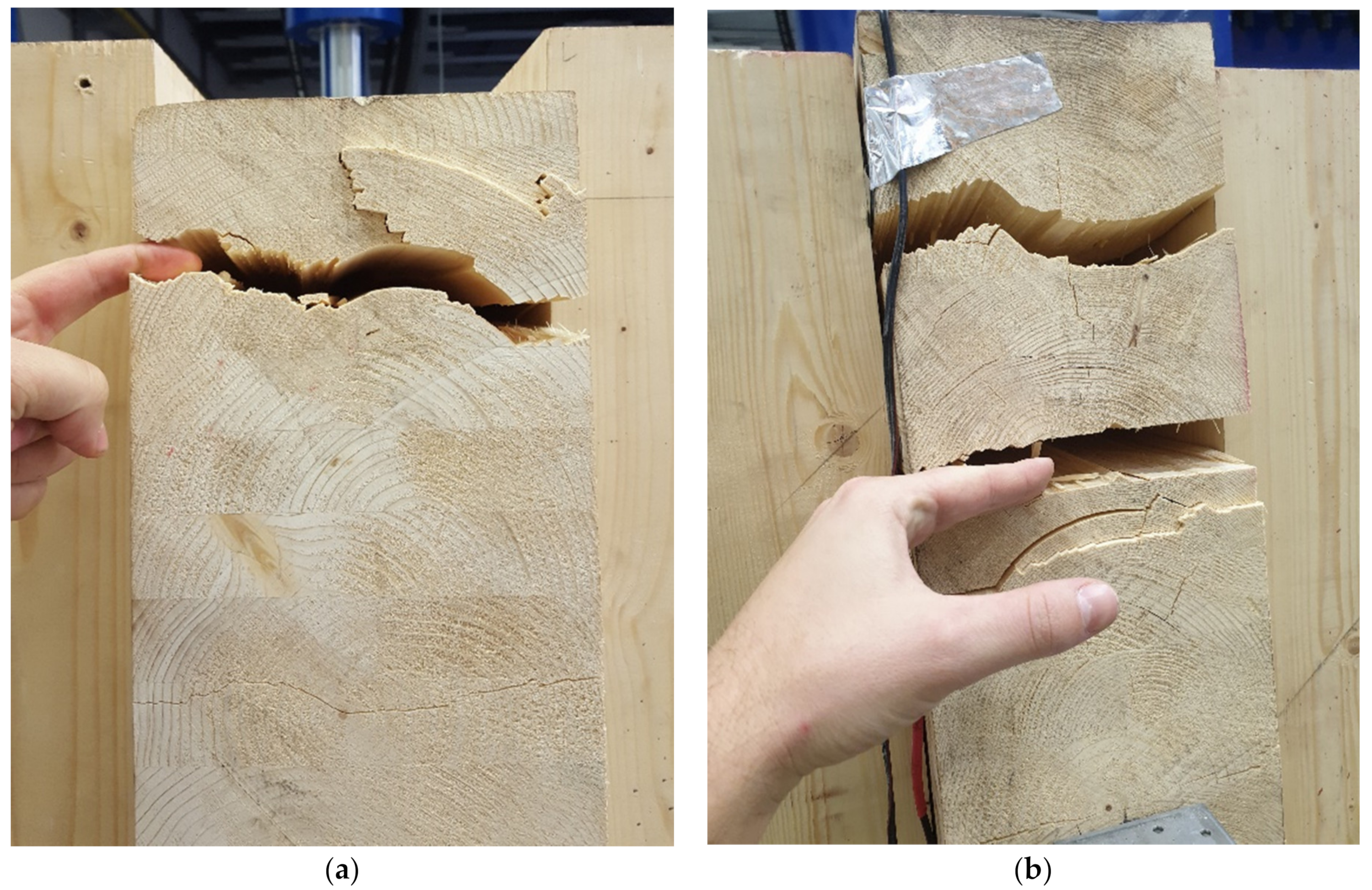


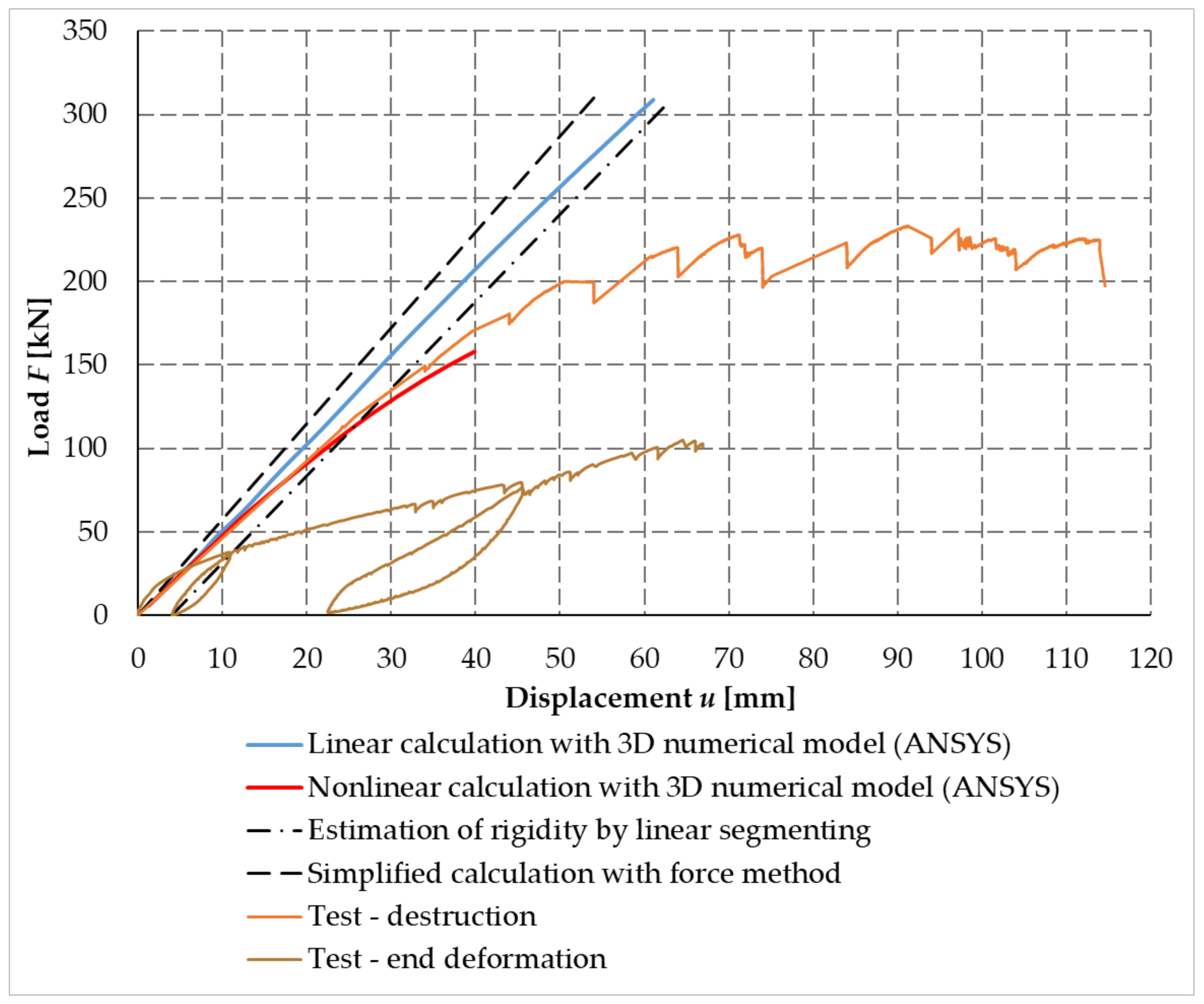

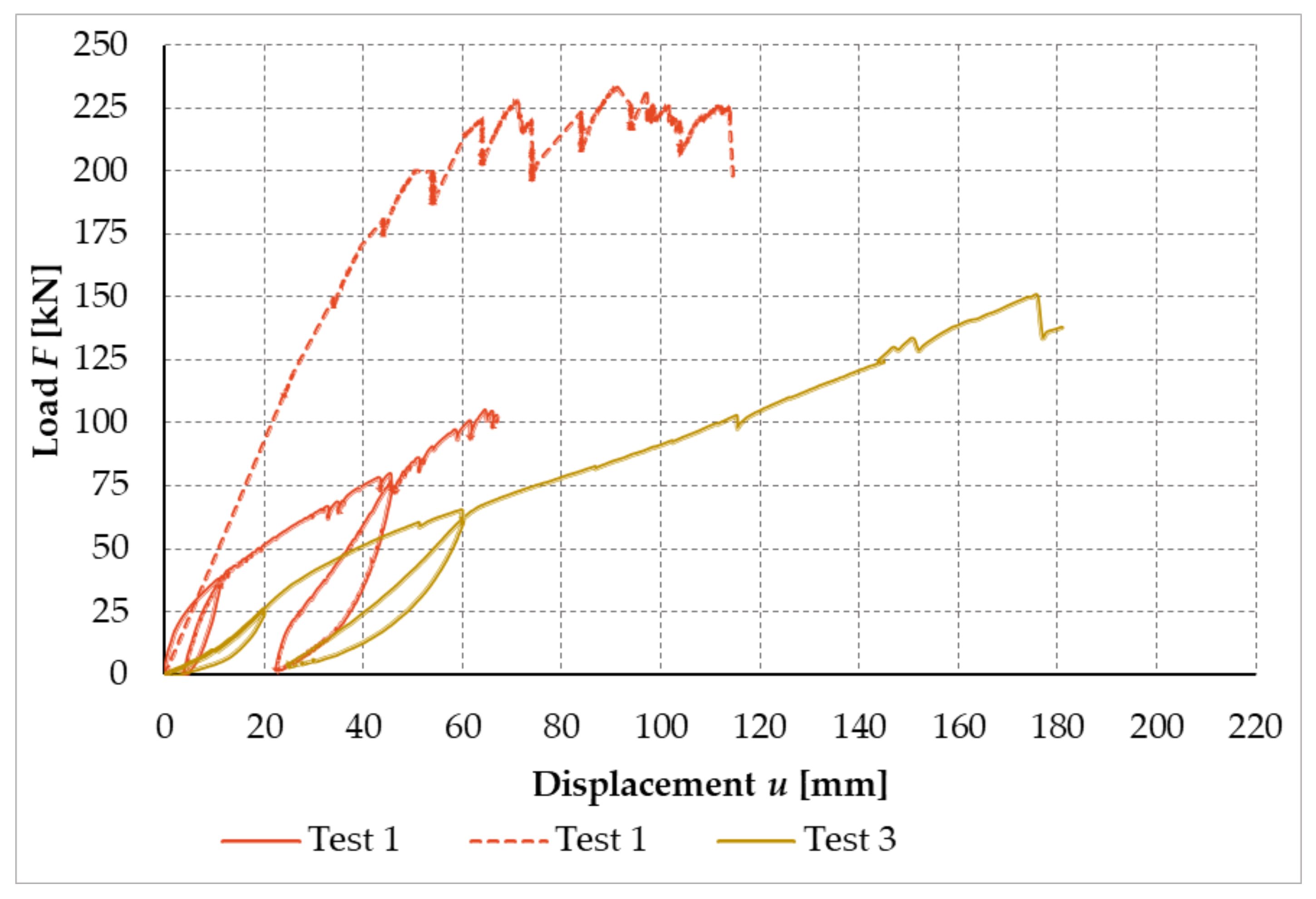
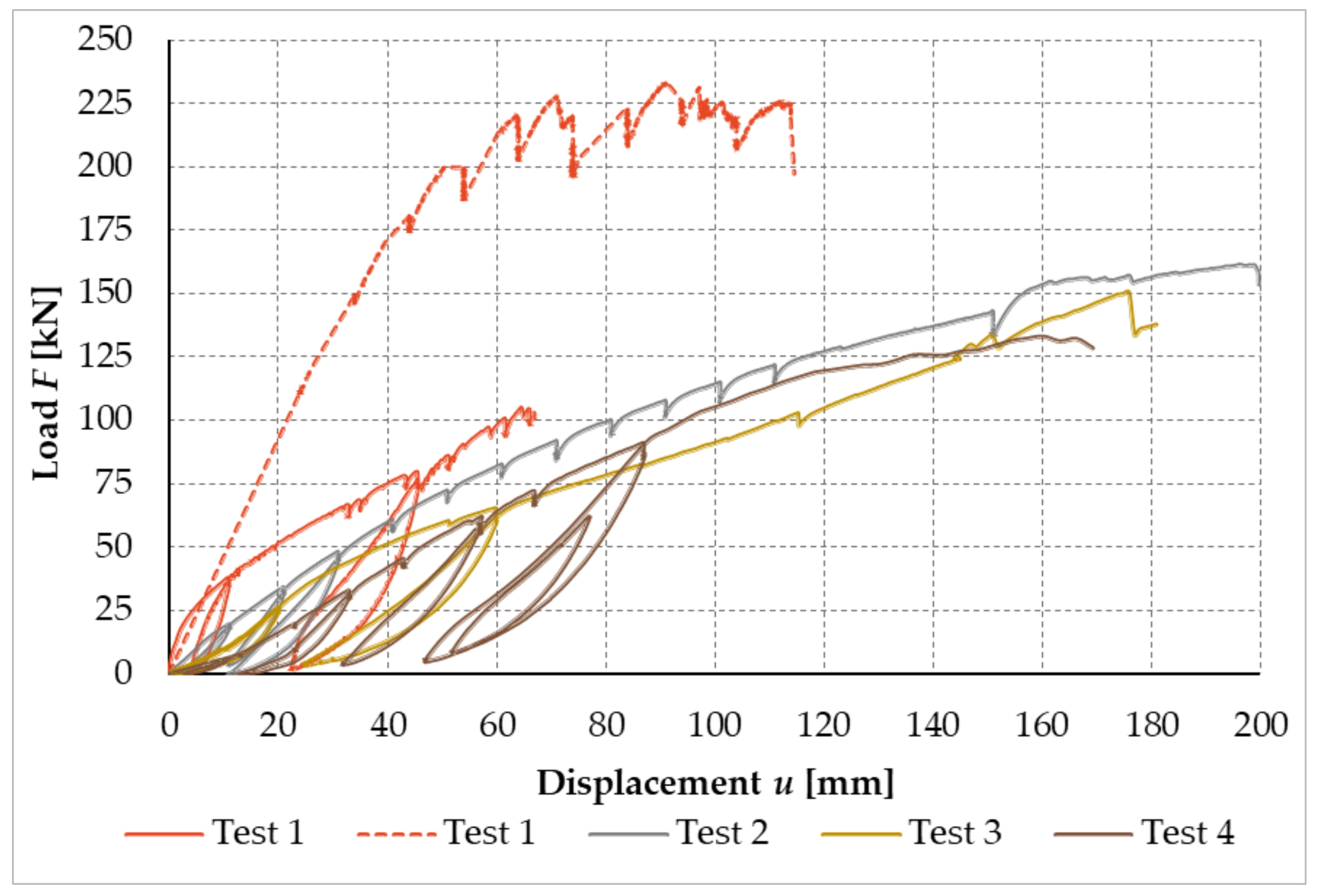
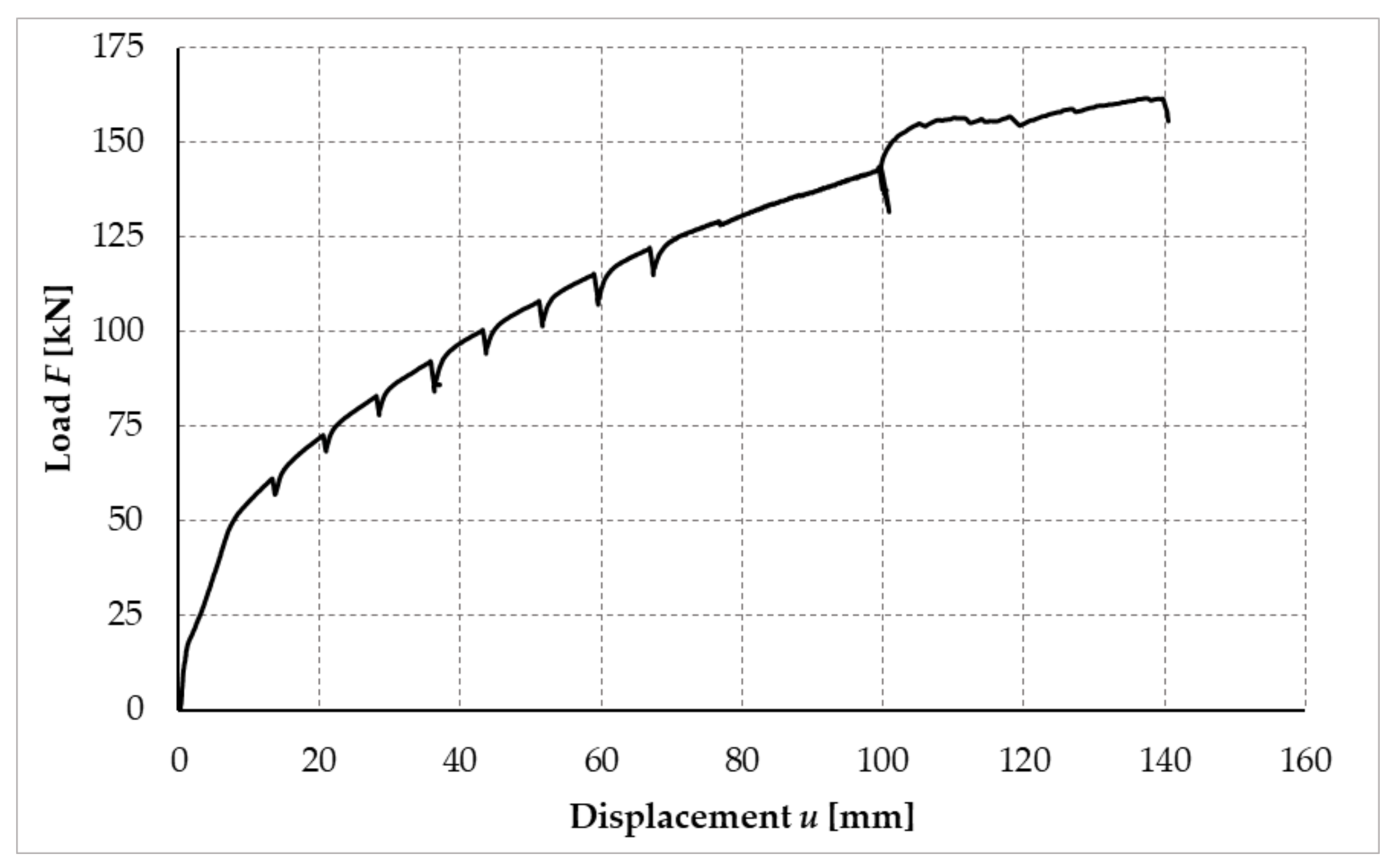
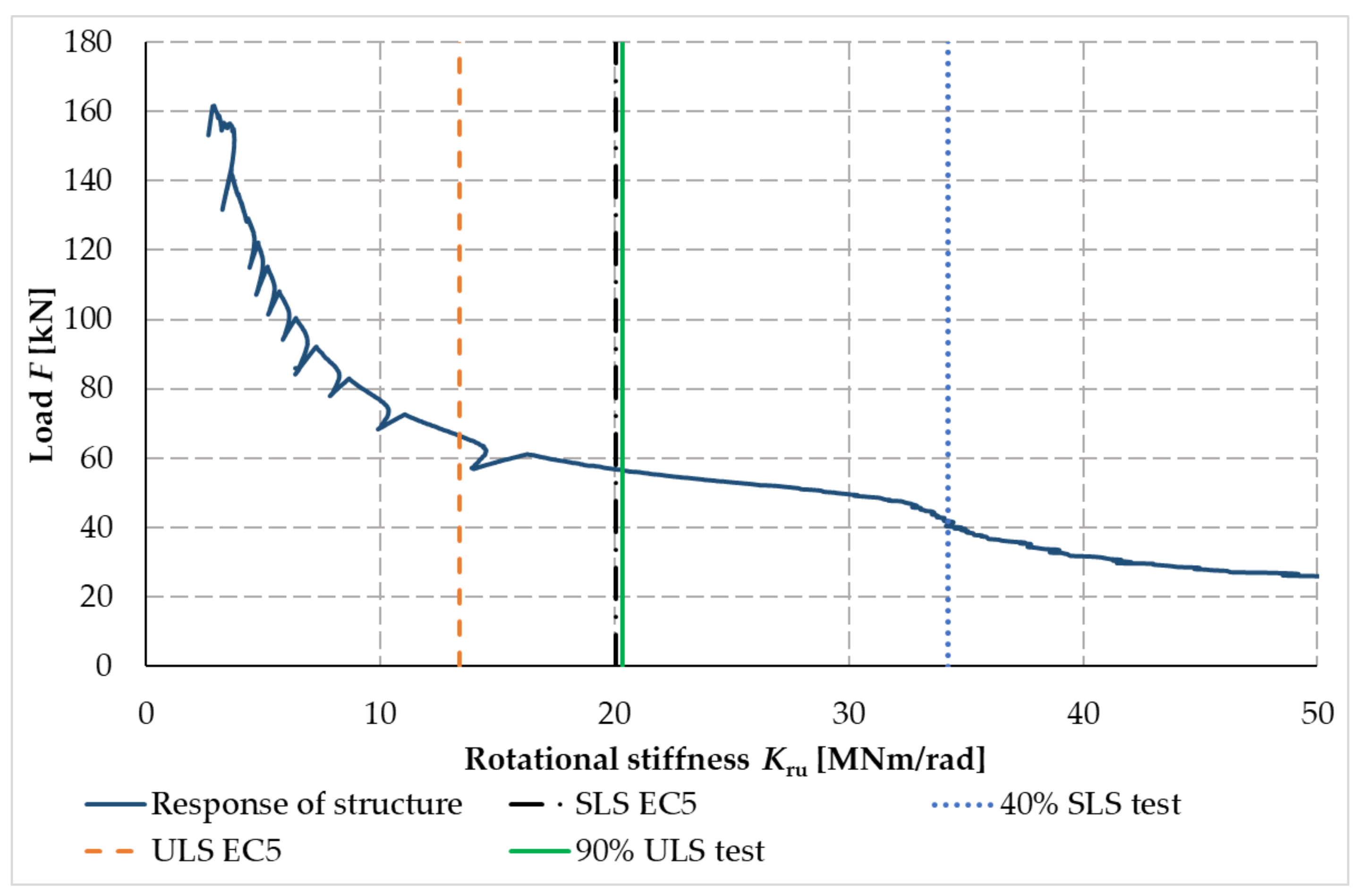
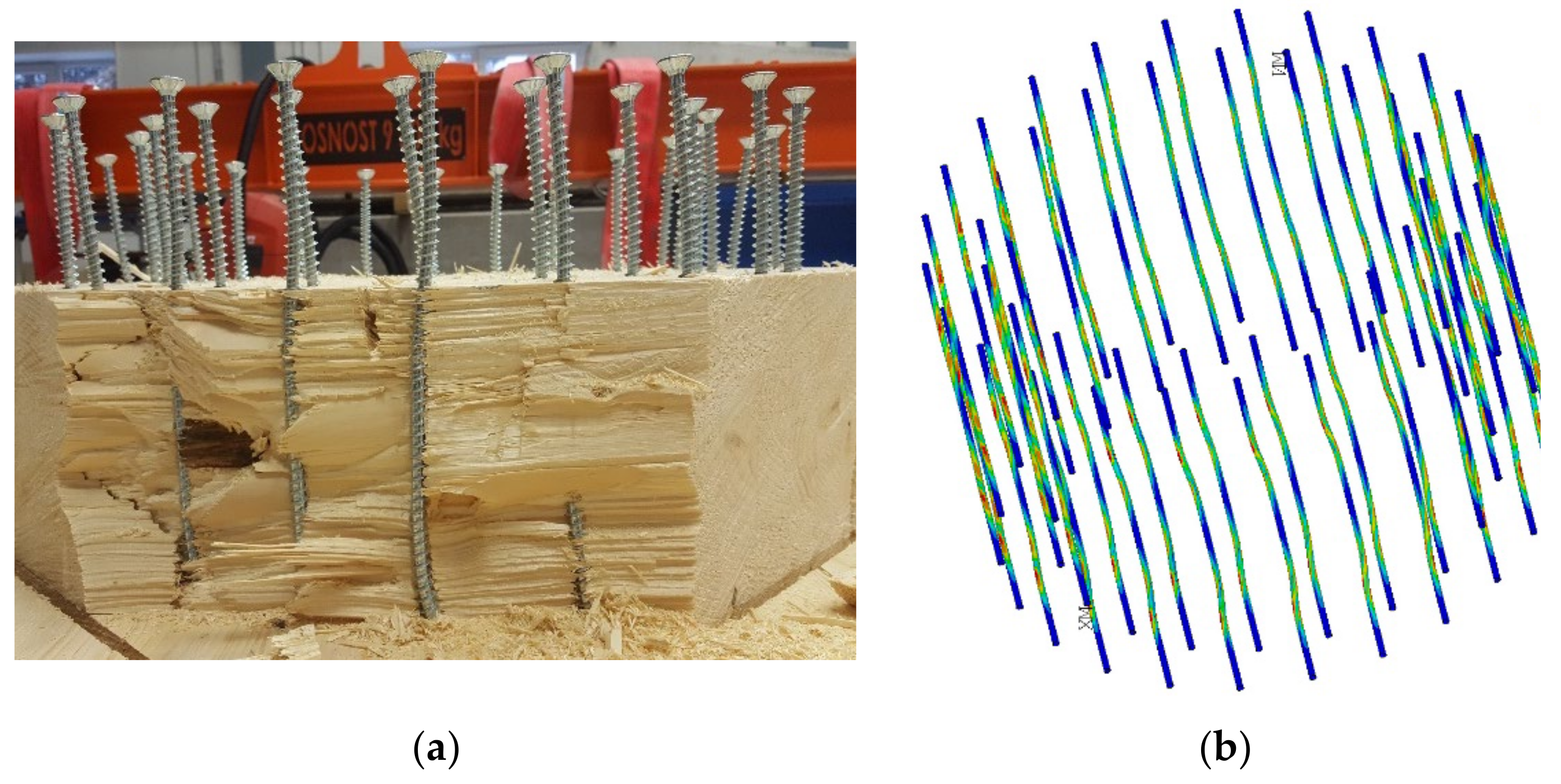

| Loading Step | From (kN) | To (kN) |
|---|---|---|
| Step 1 | 0 = 0 | 0.40 × Ftest = 40.80 |
| Step 2 | Hold | |
| Step 3 | 0.40 × Ftest = 40.80 | 0.10 × Ftest = 10.20 |
| Step 4 | Hold | |
| Step 5 | 0.10 × Ftest = 10.20 | 0.70 × Ftest = 71.40 |
| Step 6 | 0.70 × Ftest = 71.40 | Ftest = 102.00 |
| Loading Step | From (kN) | To (kN) |
|---|---|---|
| Step 1 | 0 = 0 | 0.40 × Ftest = 52.80 |
| Step 2 | Hold | |
| Step 3 | 0.40 × Ftest = 52.80 | 0.10 × Ftest = 13.20 |
| Step 4 | Hold | |
| Step 5 | 0.10 × Ftest = 13.20 | 0.70 × Ftest = 92.40 |
| Step 6 | 0.70 × Ftest = 92.40 | Ftest = 132.00 |
| Element Width | Modulus of Elasticity of Wood | Modulus of Elasticity in Torsion | Poisson’s Ratio | ||||
|---|---|---|---|---|---|---|---|
| Parallel to the Fibers | Perpendicular to the Fibers | ||||||
| h | E|| | E┴ | G13 | G23 | G12 | ν12 | ν21 |
| (m) | (GPa) | (GPa) | (-) | ||||
| 0.12 | 11 | 1 | 0.7 | 0.7 | 1.5 | 0.34 | 0.031 |
| 0.18 | 11 | 1 | 0.7 | 0.7 | 1.5 | 0.34 | 0.031 |
| Orthotropic Elasticity | Value | Units |
|---|---|---|
| Young’s Modulus X direction | 11,000 | MPa |
| Young’s Modulus Y direction | 821 | MPa |
| Young’s Modulus Z direction | 455 | MPa |
| Poisson’s Ratio XY | 0.44 | - |
| Poisson’s Ratio YZ | 0.57 | - |
| Poisson’s Ratio XZ | 0.56 | - |
| Shear Modulus XY | 555 | MPa |
| Shear Modulus YZ | 500 | MPa |
| Shear Modulus XZ | 677 | MPa |
| N | α | r | x | y | (g) | (h) | (j) | (k) | Fax | Fv.Rk | Fv.E | Use |
|---|---|---|---|---|---|---|---|---|---|---|---|---|
| 19 | 270.00 | 273.00 | −273.00 | 0.00 | 38.64 | 20.57 | 13.11 | 6.06 | 5.32 | 22.77 | 22.73 | 99.79 |
| N | α | r | x | Y | (g) | (h) | (j) | (k) | Fax | Fv,Rk | Fv,E | Use |
|---|---|---|---|---|---|---|---|---|---|---|---|---|
| 18 | 278.18 | 266.00 | −263.29 | 37.85 | 39.71 | 20.37 | 14.13 | 10.44 | 1.08 | 20.89 | 20.88 | 99.95 |
| Method of Calculation | Force Causing Collapse F (kN) | Bending Moment Causing Collapse (kNm) | Multiplier M (−) |
|---|---|---|---|
| Standard calculation EC5 [40] | 132.00 | 198.00 | - |
| ANSYSTM—linear calculation | 308.89 | 469.51 | 1.96 |
| ANSYSTM—nonlinear calculation | 157.94 | 240.07 | 1.20 |
| Experimental test | 150.40 | 225.60 | 1.14 |
| Test No. | Capacity Experimental Testing (kN) | Capacity Analytical Calculation (kN) | Ratio (−) |
|---|---|---|---|
| 1 | 233.30 | 132.00 | 1.767 |
| 2 | 161.30 | 102.00 | 1.581 |
| 3 | 150.40 | 132.00 | 1.139 |
| 4 | 133.00 | 102.00 | 1.304 |
| Frame Connection | Serviceability Limit State | Ultimate Limit State | Load Value (%) | Ratio (−) | ||||
|---|---|---|---|---|---|---|---|---|
| F (kN) | Kr (MNm/rad) | EC5 | F (kN) | Kr (MNm/rad) | EC5 | |||
| Bolt | 40.80 | 34.258 | 20.081 | - | - | - | 40 | 1.706 |
| - | - | - | 56.44 | 20.338 | 13.387 | 90 | 1.519 | |
| Screws | 52.49 | 36.902 | 22.552 | - | - | - | 40 | 1.636 |
| - | - | - | 73.28 | 21.617 | 15.033 | 90 | 1.438 | |
Publisher’s Note: MDPI stays neutral with regard to jurisdictional claims in published maps and institutional affiliations. |
© 2021 by the authors. Licensee MDPI, Basel, Switzerland. This article is an open access article distributed under the terms and conditions of the Creative Commons Attribution (CC BY) license (https://creativecommons.org/licenses/by/4.0/).
Share and Cite
Johanides, M.; Mikolasek, D.; Lokaj, A.; Mynarcik, P.; Marcalikova, Z.; Sucharda, O. Rotational Stiffness and Carrying Capacity of Timber Frame Corners with Dowel Type Connections. Materials 2021, 14, 7429. https://doi.org/10.3390/ma14237429
Johanides M, Mikolasek D, Lokaj A, Mynarcik P, Marcalikova Z, Sucharda O. Rotational Stiffness and Carrying Capacity of Timber Frame Corners with Dowel Type Connections. Materials. 2021; 14(23):7429. https://doi.org/10.3390/ma14237429
Chicago/Turabian StyleJohanides, Marek, David Mikolasek, Antonin Lokaj, Petr Mynarcik, Zuzana Marcalikova, and Oldrich Sucharda. 2021. "Rotational Stiffness and Carrying Capacity of Timber Frame Corners with Dowel Type Connections" Materials 14, no. 23: 7429. https://doi.org/10.3390/ma14237429






